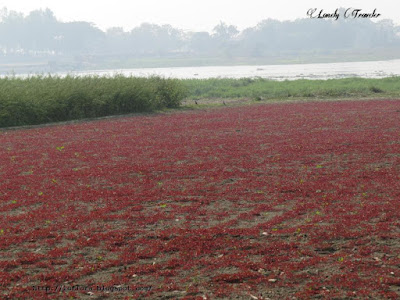| Common Name : | Red Amaranth, Red spinach |
| Binomial Name : | Amaranthus gangeticus |
| Family : | Amaranthaceae |
| Bangla Name : | Lal shak (লাল শাক) |
| Photo Taken : | Bangladesh |
Botanical Identity
Amaranthus gangeticus, commonly known as Red Amaranth, Lal Shak (in Bengali), is a leafy vegetable plant cultivated for its tender, reddish leaves. It belongs to the Amaranthaceae family and is native to the Indian subcontinent, particularly the Ganges River region, from which its species name "gangeticus" is derived. This plant is popular across South and Southeast Asia, both as a food crop and an ornamental species due to its striking coloration.Plant Description and Growth Habit
Amaranthus gangeticus is a fast-growing annual herb that can reach heights of 30 to 100 cm. It has soft, upright stems with broad, ovate leaves that are characteristically deep red or purple, especially on the underside. The plant thrives in warm, humid climates and grows best in well-drained, loamy soils with ample sunlight. It is commonly grown in home gardens, kitchen plots, and small-scale farms, often harvested multiple times during its growing season by cutting the top shoots.Flowers and Seed Characteristics
The plant produces small, inconspicuous flowers that are typically reddish or greenish and are borne in dense, elongated clusters at the leaf axils or stem tips. The flowering stage appears in the later part of its life cycle and leads to the production of numerous small, black to brown seeds. These seeds are often harvested and stored for propagation or, in some regions, consumed like grain. Though not grown for ornamental flowers, the plant’s vibrant red-purple foliage offers visual appeal.Uses and Nutritional Value
Lal Shak is widely consumed as a nutritious leafy green vegetable, often stir-fried, sautéed, or steamed with garlic and spices. It is rich in iron, calcium, vitamin A, vitamin C, and antioxidants such as betalains, which give the leaves their red color. Traditionally, it is believed to aid in improving blood health, digestion, and skin conditions. Apart from human consumption, the plant is also used as fodder for livestock and in some regions, for soil enrichment. Its combination of aesthetic appeal and high nutritional value makes Amaranthus gangeticus a staple in South Asian diets.A red field of Amaranth from a farmer's field.
Red Amaranth cultivation beside the river Dhaleswari.
Photos of this article were taken from the following locations:
1) January 2015: Vaorviti, Munshiganj, Bangladesh.
2) January 2016: Jamalpur, Bangladesh.
3) August 2023: Ireland. I was growing this in my backyard. But it is very challenging to grow here in Ireland because of the weather. I ended up having flowers on my plant very early.
Written by Lonely Traveler,
For blog icflora.blogspot.com








Comments
Post a Comment